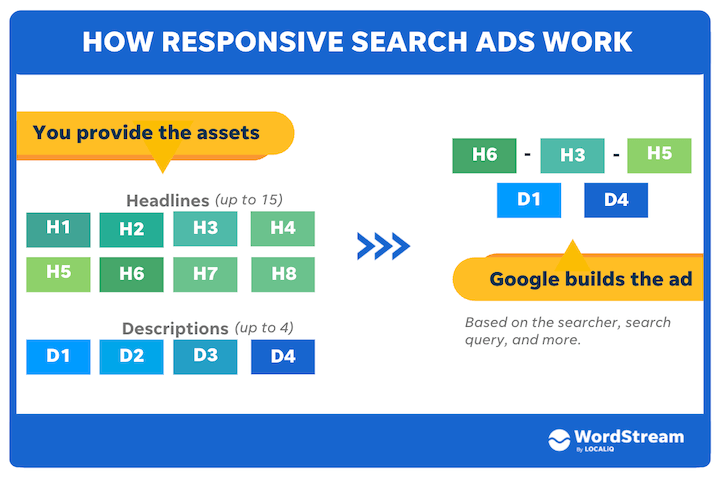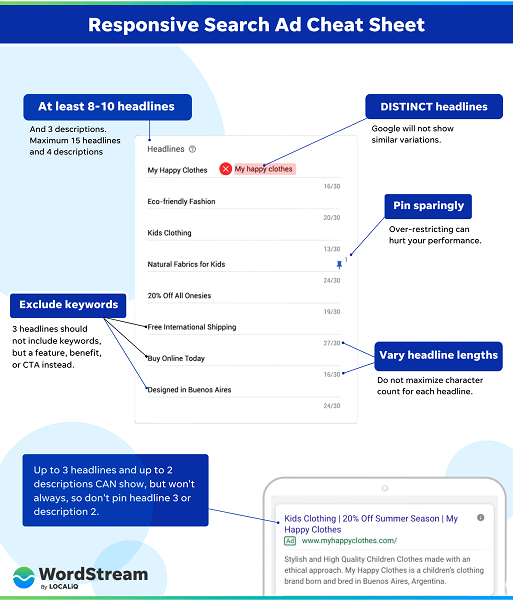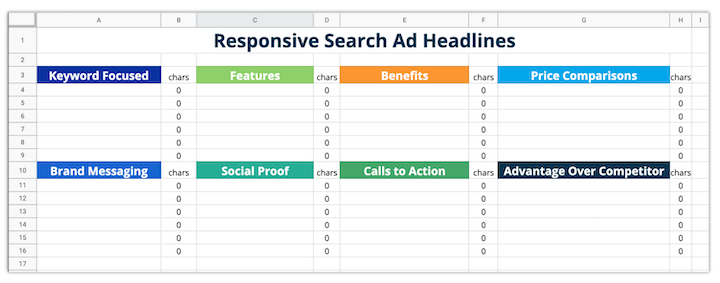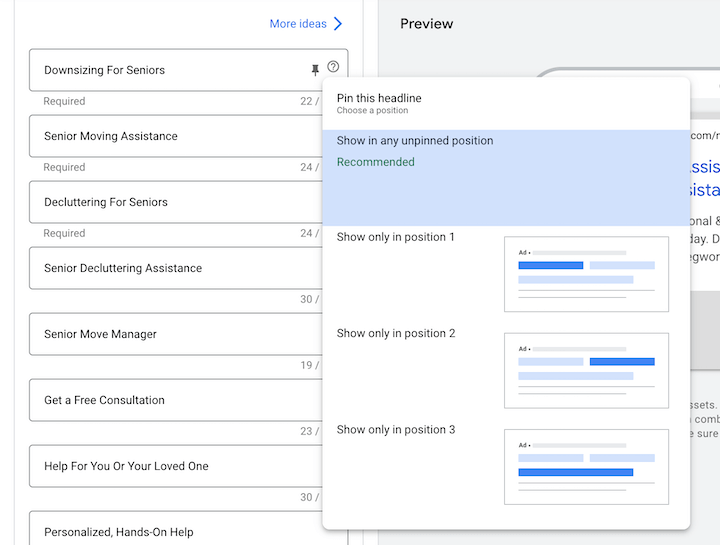Unlock the secrets to crafting compelling copy for Responsive Search Ads and transform your advertising game forever. Don’t miss out!

Image courtesy of via DALL-E 3
Table of Contents
Introduction to Responsive Search Ads
Responsive Search Ads (RSAs) are an essential tool in the world of digital marketing, particularly through platforms like Google Ads. These ads are designed to adapt to the needs of users by automatically testing different combinations of headlines and descriptions to determine the most effective ones. This automated process enables advertisers to reach a wider audience with more relevant and engaging ads.
What Are RSAs?
RSAs are a type of ad format where advertisers can input multiple headlines and descriptions. Google’s algorithm then dynamically selects and combines these elements to create ads that are most likely to resonate with individual users. This means that each time an RSA is shown, it could potentially have a different headline or description based on what Google’s algorithm deems as the best combination.
Importance of RSAs
The beauty of RSAs lies in their ability to increase the chances of reaching potential customers with ads that are tailored to their preferences. By continuously testing and optimizing ad combinations, advertisers can improve ad performance and relevance, ultimately driving more clicks and conversions. This adaptability and data-driven approach make RSAs a powerful tool in any digital marketing strategy.
How RSAs Work
Responsive Search Ads (RSAs) are a powerful tool in the world of digital marketing advertising. But how exactly do they work? Let’s dive into the mechanics behind RSAs and understand the role of automation in creating effective ad combinations.
Creating Ad Combinations
When advertisers set up RSAs, they input multiple headlines and descriptions that they believe could work well together. These could be different variations of messages that highlight the key features or benefits of their products or services. Once these inputs are provided, Google’s algorithm takes over and starts mixing and matching these headlines and descriptions to create various ad combinations.
Automation in RSAs
Google’s machine learning technology kicks in to determine which combinations are most likely to resonate with different users. By analyzing user behavior, preferences, and other contextual factors, Google can predict which ad copy is more likely to result in clicks and conversions. This automation allows advertisers to reach their target audience with the most relevant and engaging ads without having to manually test each combination themselves.
Writing Headlines for RSAs
When crafting headlines for your Responsive Search Ads (RSAs), it’s essential to keep them short and concise. Short headlines are easier for users to digest quickly, increasing the chances of capturing their attention. Remember, you only have a limited amount of space to make an impact, so make every word count!

Image courtesy of via Google Images
Use Keywords Wisely
Keywords play a crucial role in improving the relevance and performance of your RSAs. By strategically incorporating relevant keywords into your headlines, you can increase the chances of your ad showing up for relevant searches. Identify key phrases that your target audience is likely to search for and seamlessly integrate them into your headlines for maximum impact.
Writing Descriptions for RSAs
When it comes to crafting descriptions for your Responsive Search Ads (RSAs), there are a few key guidelines to keep in mind. Descriptions play a vital role in complementing your headlines and providing more information to potential customers. Let’s delve into how you can write compelling descriptions that enhance the overall effectiveness of your RSAs.
Be Clear and Informative
One of the essential aspects of writing descriptions for RSAs is ensuring clarity and informativeness. Your descriptions should clearly communicate the offer or message you want to convey to your audience. Avoid using vague language or complex sentences that might confuse potential customers. Instead, focus on providing clear and concise information that helps users understand the value proposition of your product or service.
Highlight Unique Selling Points
Another crucial element to consider when writing descriptions for RSAs is highlighting your unique selling points. What sets your product or service apart from the competition? Use your descriptions to showcase what makes your offering special and why customers should choose you over other options. Whether it’s a unique feature, a special promotion, or exceptional customer service, make sure to emphasize these aspects in your descriptions to capture the attention of your target audience.
Using Keywords in Ad Copy
Keywords are the words or phrases that people type into search engines when looking for information online. It’s essential to choose the right keywords for your ad copy to ensure that your ads show up when potential customers are searching for products or services like yours. One way to find the best keywords to use in your ad copy is through keyword research.

Image courtesy of via Google Images
Balancing Keywords and Readability
While including keywords is important for search engine optimization (SEO) and ad relevance, it’s equally crucial to maintain natural, readable sentences in your ad copy. Striking a balance between inserting keywords and ensuring that your ad copy flows well and makes sense to the reader is key.
Testing and Optimizing RSAs
In order to maximize the effectiveness of your Responsive Search Ads (RSAs), it is crucial to continuously test and optimize them based on performance data. This process involves setting up tests to analyze the results and make data-driven decisions for improvement.
Setting Up Tests
When setting up tests for your RSAs, it’s essential to focus on different ad elements such as headlines and descriptions. By creating A/B tests, where you change one variable at a time and compare the results, you can identify what resonates best with your target audience.
Analyzing Results
Once you have run your tests, it’s time to analyze the results to determine which ad combinations are performing the best. Look at metrics like click-through rate (CTR), conversion rate, and cost per acquisition to understand which variations are driving the most success. By interpreting this data, you can optimize your RSAs for better performance.
Common Mistakes to Avoid
When it comes to creating effective Responsive Search Ads (RSAs), there are some common pitfalls that advertisers should steer clear of to maximize the performance of their ads. By avoiding these mistakes, you can ensure that your RSAs are engaging, relevant, and drive results.

Image courtesy of via Google Images
Avoid Vague Headlines
One of the most crucial mistakes to avoid when writing RSAs is using vague or generic headlines. Your headlines should be specific, attention-grabbing, and directly related to the offer. Vague headlines can confuse potential customers and may not effectively communicate the value of your product or service. Make sure your headlines are clear, concise, and highlight the unique selling points of your business.
Don’t Ignore Data
Another common mistake that advertisers make with RSAs is neglecting the importance of data analysis. It’s essential to regularly review the performance metrics of your ads to understand what is working and what isn’t. By analyzing data such as click-through rates, conversion rates, and engagement metrics, you can make informed decisions about how to optimize your RSAs for better results. Ignoring data can lead to missed opportunities for improvement and hinder the success of your ad campaigns.
Tools and Resources for RSAs
In order to effectively create, manage, and optimize your Responsive Search Ads (RSAs), it’s essential to utilize various tools and resources that can support your digital marketing efforts. Here are some valuable resources to help you make the most out of your RSAs:
Google Ads Support
When diving into the world of RSAs, it’s beneficial to tap into the wealth of resources offered by Google Ads support. Google provides comprehensive documentation, tutorials, and troubleshooting guides to help you understand and navigate the intricacies of RSAs. Whether you’re a beginner looking to learn the basics or an experienced advertiser seeking advanced insights, Google Ads support is a valuable ally in your digital marketing journey.
Keyword Research Tools
One of the key components of crafting effective RSAs is utilizing relevant keywords that resonate with your target audience. To streamline your keyword research process, consider leveraging tools like Google Keyword Planner. This tool allows you to explore keyword ideas, analyze search volumes, and identify potential keywords to incorporate into your ad copy. By conducting thorough keyword research, you can enhance the relevance and visibility of your RSAs, ultimately driving better performance and engagement.
Summary and Key Takeaways
In this article, we have explored the world of Responsive Search Ads (RSAs) and how they can benefit digital marketing campaigns. By allowing Google to automatically test different combinations of headlines and descriptions, advertisers can reach more people with relevant ads efficiently.

Image courtesy of via Google Images
Recap of Key Points
We learned that RSAs are ads where Google’s algorithm tests different combinations of headlines and descriptions to find the best-performing ones. Writing effective copy for RSAs involves crafting engaging headlines that are concise and include relevant keywords. Additionally, creating compelling descriptions that are clear, informative, and highlight unique selling points is key to a successful RSA campaign. Integrating keywords strategically and balancing them with readability is crucial for ad performance. Testing and optimizing ad combinations based on data analysis can significantly improve overall campaign results.
Final Tips for Success
For creating successful RSAs, remember to continuously test and optimize ad combinations to improve performance. Avoid vague headlines and always analyze data to make informed decisions. Utilize tools like Google Ads support and keyword research tools to enhance your RSA campaigns.
By implementing these strategies and tips, advertisers can maximize the potential of their Responsive Search Ads and achieve better results in their digital marketing efforts.
Want to turn these SEO insights into real results? Seorocket is an all-in-one AI SEO solution that uses the power of AI to analyze your competition and craft high-ranking content.
Seorocket offers a suite of powerful tools, including a Keyword Researcher to find the most profitable keywords, an AI Writer to generate unique and Google-friendly content, and an Automatic Publisher to schedule and publish your content directly to your website. Plus, you’ll get real-time performance tracking so you can see exactly what’s working and make adjustments as needed.
Stop just reading about SEO – take action with Seorocket and skyrocket your search rankings today. Sign up for a free trial and see the difference Seorocket can make for your website!
Frequently Asked Questions (FAQs)
What are Responsive Search Ads?
Responsive Search Ads (RSAs) are a type of advertisement where Google automatically tests different combinations of headlines and descriptions to determine which ones perform the best. This helps your ads reach more people with tailored messages that are relevant to their search queries.
How many headlines and descriptions should I include?
It is recommended to include at least 3 to 5 headlines and 2 to 3 descriptions in your RSA. By providing Google with more options to choose from, you increase the chances of your ad being shown to the right audience with the most effective message.







